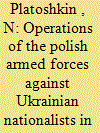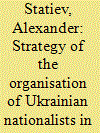| Srl | Item |
| 1 |
ID:
139735


|
|
|
|
|
| Summary/Abstract |
TODAY'S POLAND, or, more accurately, its leadership, in a strange way supports the openly extremist nationalistic regime that took power in Kiev in February 2014 and glorifies the exploits of Ukrainian nationalists during the Second World War. But Stepan Bandera and other leaders of the Organization of Ukrainian Nationalists (OUN) had their arms up to the elbows in Polish blood. Forgetting this means encouraging modern followers of Bandera to commit similar atrocities. And they have been trying hard as well, for example burning people alive in Odessa, something their predecessors had done in Poland, and not too long ago either.
|
|
|
|
|
|
|
|
|
|
|
|
|
|
|
|
| 2 |
ID:
171211


|
|
|
|
|
| Summary/Abstract |
The armed resistance offered by the Organization of Ukrainian Nationalists (OUN) to the Soviet state was the toughest internal political challenge that the Soviet regime faced from World War II to the 1980s. However, OUN’s grand strategy was based on self-delusion and was, therefore, always irrational. It resulted in misinterpretation of the sentiments of Ukrainians and the international situation, collaboration with Nazi Germany despite incompatible goals, counterproductive ethnic violence and sweeping terror against alleged Soviet collaborators. Local civilians rather than the representatives of the Soviet regime were OUN’s primary target; this alienated most residents of Western Ukraine.
|
|
|
|
|
|
|
|
|
|
|
|
|
|
|
|
| 3 |
ID:
083483


|
|
|
|
|
| Publication |
2008.
|
| Summary/Abstract |
Soviet partisans faced formidable challenges in regions annexed after the Nazi-Soviet Pact. In the pre-1939 territories, most partisans were locals; they operated within a familiar, often friendly social environment; their political goals were secondary to their military ones; and they targeted the Axis forces and their collaborators. In the western provinces, however, most partisans were outsiders; their political objectives dominated others; and they fought local nationalists as much as they did the Axis. Borderland residents were either indifferent or hostile to communist ideology, yet their attitude towards the partisans was complex. It depended on their economic status, regional variations of the Soviet policy in 1939-41, Axis occupation practices, the situation on the fronts, the strength of nationalist sentiments, local political culture and ethnic strains. The intricate interaction of these factors determined whether partisans succeeded or failed.
|
|
|
|
|
|
|
|
|
|
|
|
|
|
|
|